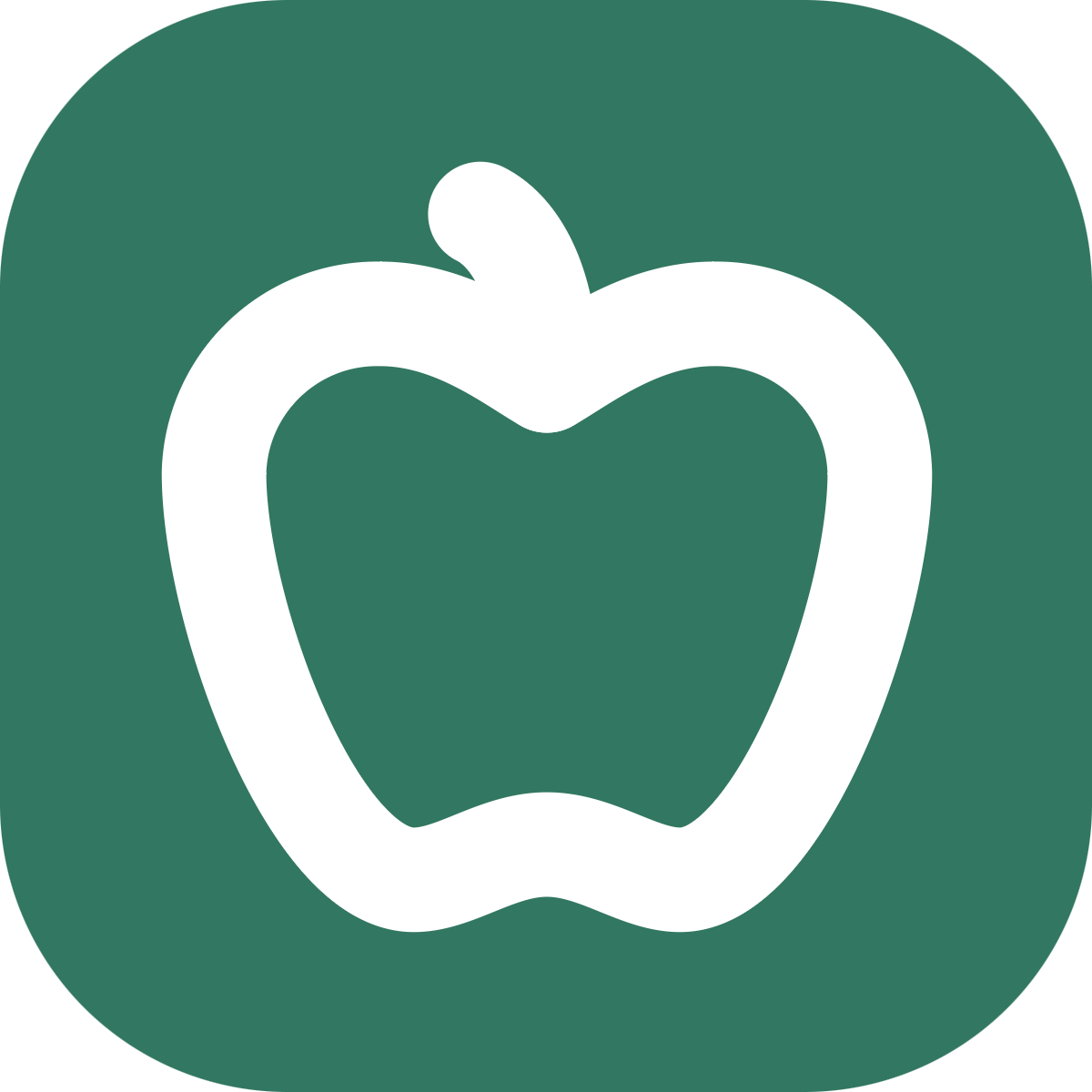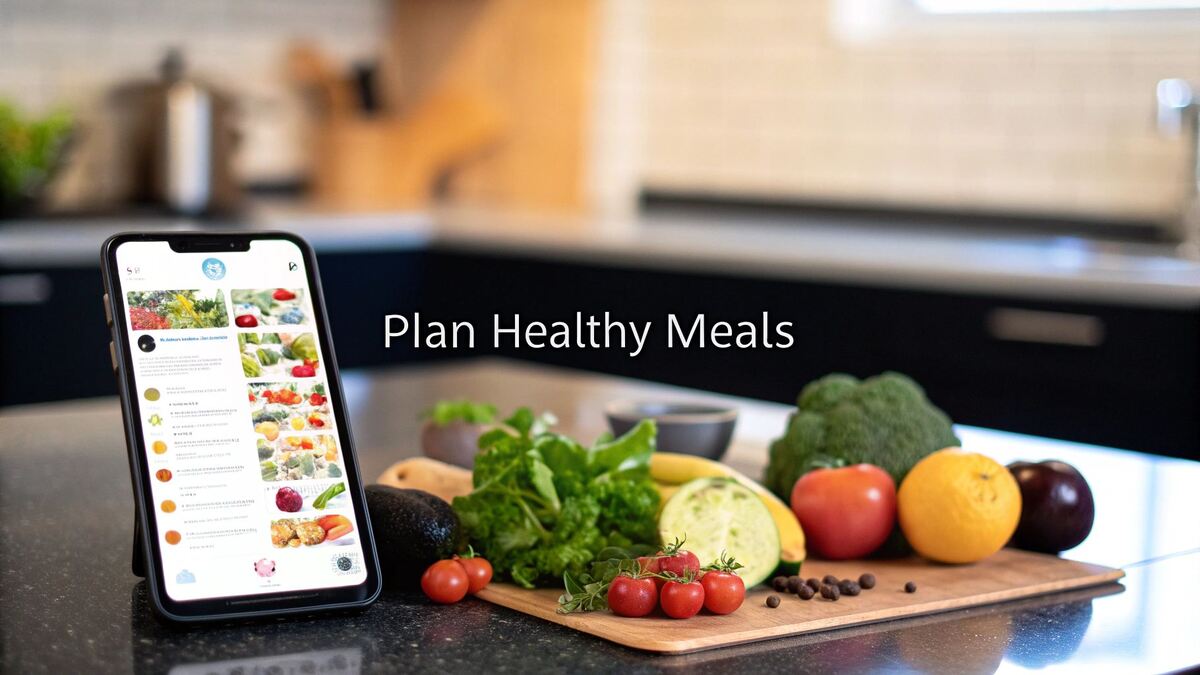Your Guide to the Best Healthy Meal Planning App
A healthy meal planning app is essentially a digital sidekick designed to take the guesswork out of eating well. Think of it as having a personal nutritionist right in your pocket. These apps help you find new recipes, map out your meals for the week, and even whip up a perfectly organized grocery list. The goal? To make healthy eating less of a chore and more of a habit.
Why Meal Planning Apps Are Your New Nutritionist
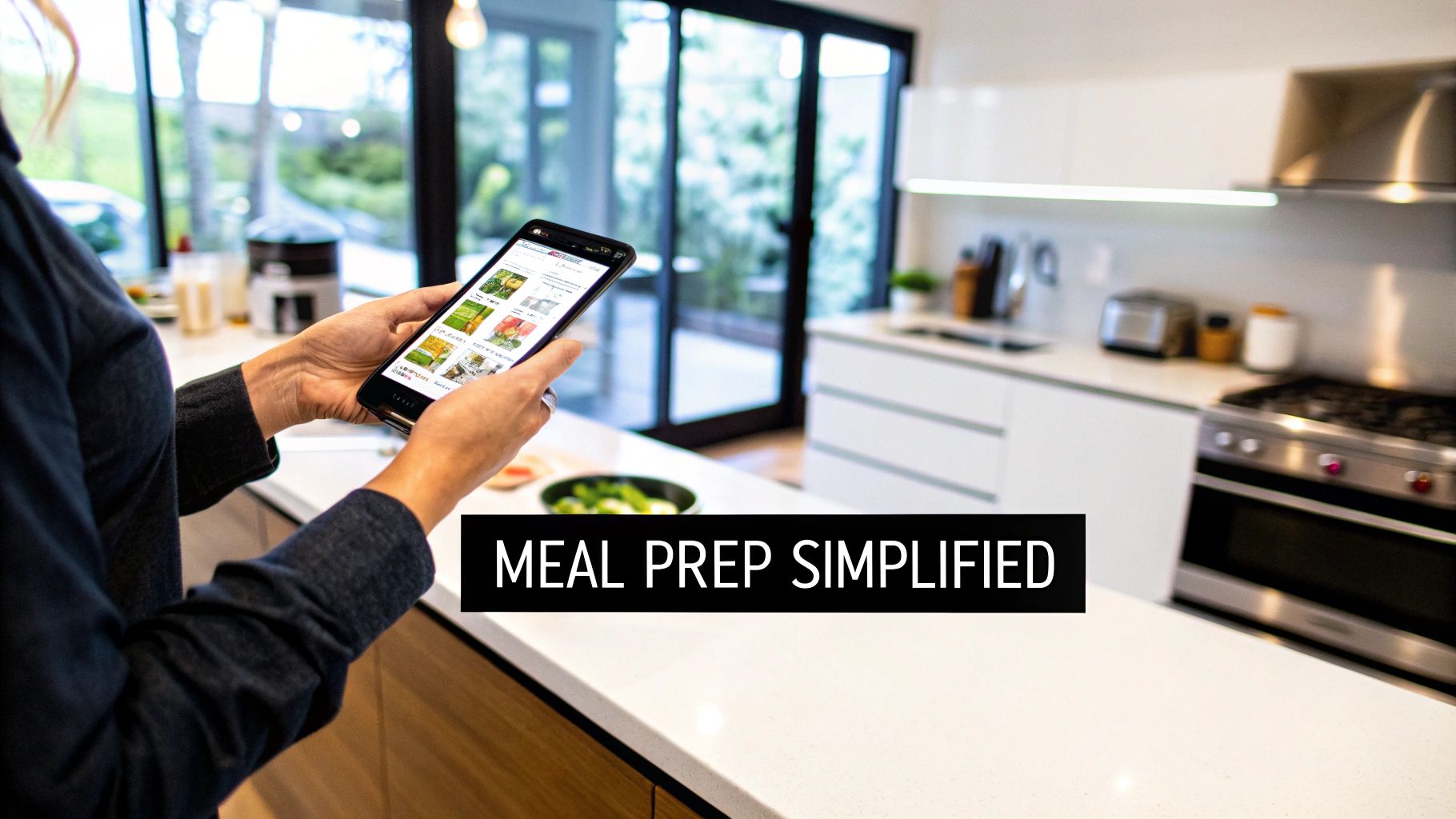
We've all been there: staring into a packed fridge, yet feeling like there's absolutely nothing to eat. That moment of frustration—decision fatigue—is exactly when we're most likely to grab takeout or make an unhealthy choice out of sheer convenience. This is the exact problem a good meal planning app is built to solve. It replaces that daily indecision with a clear, actionable plan.
Imagine it as a GPS for your nutrition. Instead of just "winging it" and hoping for the best, the app gives you a clear path to your health goals, whether you're trying to lose weight, build muscle, or just feel more energetic. It builds a much-needed bridge between wanting to eat better and actually doing it.
Solving Common Dietary Pain Points
These apps are designed to tackle the real-world obstacles that throw so many of us off our health game. They bring structure and support right when we need it most.
- Ends Decision Fatigue: Planning your meals ahead of time means you never have to ask the dreaded "what's for dinner?" question again. That mental energy can be spent on things you actually enjoy.
- Boosts Consistency: When you have a plan, it’s so much easier to stick to your goals. You're far less likely to be swayed by impulse meals or unhealthy cravings.
- Sparks Recipe Inspiration: Tired of the same five meals? Apps unlock huge recipe libraries, helping you discover new, healthy dishes that actually fit your preferences.
At the end of the day, a meal planning app simplifies the process of figuring out what is a balanced diet and makes it feel achievable. By handling the tedious bits of meal prep, it frees you up to enjoy the fun parts—cooking and eating delicious food.
The Rise of Digital Nutrition
The surge in popularity for these apps isn't a coincidence; it mirrors a larger movement toward using technology to manage our wellness proactively. People are looking for smart, simple solutions that fit into their packed schedules. The numbers back this up: the global meal planning app market was valued at USD 1.2 billion in 2023 and is expected to hit USD 3.6 billion by 2032.
This growth is fueled by our collective desire to take back control of our health. An app provides the framework to turn good intentions into real, sustainable habits, one planned meal at a time.
This trend is about more than just convenience. It's about feeling empowered. A great tool like the AI Meal Planner can turn meal prep from a dreaded weekly task into a smooth, rewarding part of your routine. It’s proof that eating healthy can be both easy and enjoyable.
Decoding the Features of a Great Meal Planning App
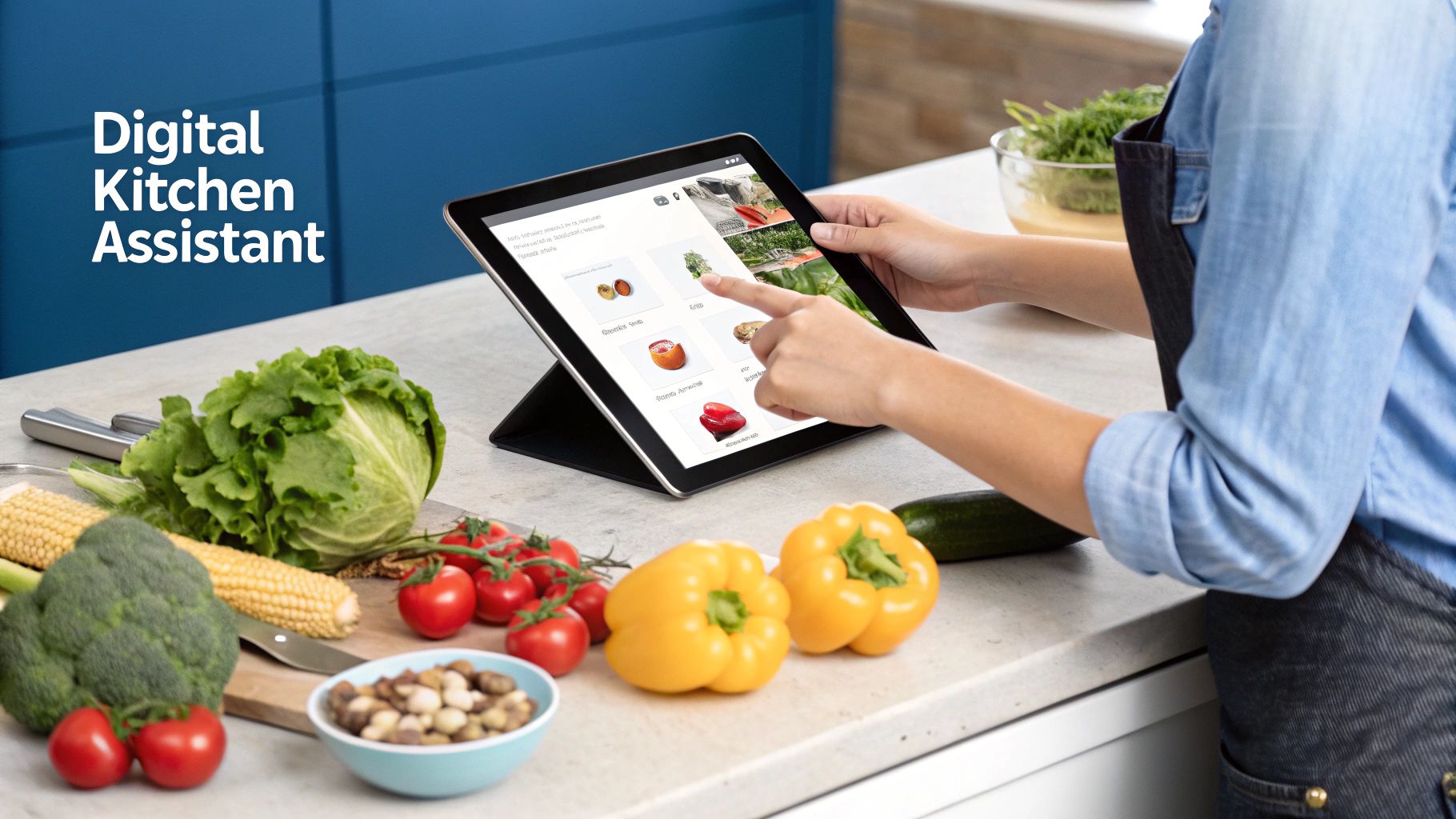
Choosing a healthy meal planning app can feel like wandering through a packed supermarket. Dozens of options are vying for your attention, all promising to make your life easier. But what really separates a simple digital cookbook from a true kitchen assistant are the features working behind the scenes.
Think of it like buying a car. Sure, they all get you from point A to B. But it’s the features—the GPS, the cruise control, the safety sensors—that define the entire experience. A great app isn't just about finding recipes; it’s about making the whole process, from planning to plating, feel effortless.
Your Personal Dietary Gatekeeper
First and foremost, a top-tier app has to understand you. This goes way beyond just ticking a "vegetarian" box. A truly great app acts as your personal dietary gatekeeper, filtering out the noise and only showing you meals that are safe and right for your body.
Look for apps that let you get really specific with your preferences, such as:
- Allergies: Set it and forget it. You should be able to permanently exclude common allergens like nuts, dairy, gluten, or shellfish from your feed.
- Dietary Preferences: Whether you're keto, paleo, vegan, low-FODMAP, or Mediterranean, the app should tailor its suggestions to fit your lifestyle.
- Ingredient Exclusions: Can't stand cilantro or bell peppers? A good app lets you banish them from your sight for good.
This level of control saves you from the headache of manually scanning every single recipe for problem ingredients. It means the meal plan you build is one you can actually follow without a bunch of frustrating tweaks.
The Automated Grocery List: Your Secret Weapon
Honestly, this might be the single most powerful feature for saving time, money, and your sanity. A smart, automated grocery list isn't just a digital notepad. It’s an intelligent tool that pulls all the ingredients from your chosen recipes for the week into one perfectly organized list.
The best apps take this even further. They’ll combine ingredients—so if three recipes need an onion, your list just says "3 onions" instead of listing it three separate times. Some even sort the list by supermarket aisle (produce, dairy, pantry) to get you in and out of the store in record time.
This feature is your best defense against two major budget-killers:
- Impulse Buys: A clear, focused list keeps you on-mission, making it much easier to walk past those tempting end-cap displays.
- Food Waste: By telling you exactly how much of everything you need, it stops you from overbuying and ensures every item in your cart has a home.
A study on consumer habits revealed that shoppers with a detailed list can reduce their grocery spending by up to 23%. An automated list generated by a healthy meal planning app essentially puts this saving on autopilot.
Robust Nutritional Tracking and Recipe Diversity
Finally, a great app should bring total clarity to what you're eating. It needs to provide detailed nutritional information for every recipe, including the macronutrient breakdown (protein, carbs, fats) and total calories. This is non-negotiable if you have specific fitness goals, like building muscle or managing your weight.
Just as important is the recipe library itself. An app is only as good as the food it helps you make. A deep and diverse collection of recipes keeps "food boredom" at bay and gets you genuinely excited to cook at home. The best platforms are constantly adding new, nutritionist-vetted meals so you never run out of fresh inspiration.
Imagine having a cookbook that not only understands your diet but also writes your shopping list and tracks your nutrition automatically. That's the real power of a well-designed meal planning app. It’s not just a tool; it’s a complete system built to support you on your health journey.
How AI Personalizes Your Plate
Think about the difference between a standard paper map and a real-time GPS. One gives you a fixed route, but the other adapts to traffic, roadblocks, and your personal driving style. That’s exactly what AI does for meal planning—it’s your personal food GPS, finding the best and most enjoyable path to your health goals.
This is a huge leap from the old way of doing things. Basic apps might let you filter for "low-carb" recipes, but an AI-powered app gets to know you. It's like having a friend who not only knows you're vegetarian but also remembers you can't stand mushrooms, love a bit of spice on Fridays, and are trying to boost your iron intake.
The Brains Behind Your Meal Plan
So, how does it all work? At its core, AI uses sophisticated algorithms to sift through massive amounts of data and spot patterns. Imagine a super-attentive nutritionist who can process your health profile, food preferences, and daily feedback in the blink of an eye.
These algorithms don't just look at one thing; they layer multiple pieces of your personal data to create meal suggestions that feel like they were made just for you.
- Your Health Goals: Want to lose weight, build muscle, or keep your blood sugar in check? The AI will serve up recipes with the right macronutrient and calorie counts to get you there.
- Dietary Restrictions and Preferences: It expertly dodges allergens and ingredients you dislike while picking up on the flavor profiles and cuisines you love most.
- Your Past Behavior: The app is always learning. It notices which recipes you save, which ones you actually cook, and how you rate them, getting smarter with every interaction.
This constant learning is what makes the experience so intuitive. If you keep giving high ratings to recipes with avocado, the app will start showing you more of them. On the other hand, if you always scroll past the fish dishes, it will slowly phase them out. The app literally evolves with you, becoming a better and better partner on your health journey.
The real magic of AI is its ability to connect the dots between what you say you want and what your actions show you truly enjoy. It closes that gap to deliver meals that aren't just healthy, but genuinely satisfying.
This level of intelligence is why the market for AI-driven meal planning apps is booming. Valued at $0.67 billion in 2024, it’s projected to hit $0.83 billion by 2025 and keep climbing. People are hungry for this kind of personalization, and the technology is finally here to deliver it.
From Generic Plan to Personalized Experience
The difference between a static, one-size-fits-all meal plan and an AI-generated one is night and day. A generic plan is a blunt instrument. AI, however, is a scalpel, precisely tailoring every suggestion to fit the unique pieces of your life.
For instance, if you're looking for plant-based ideas, it won't just throw a bunch of random salads at you. It will find creative, protein-packed meals that actually excite you. You can see this in action by exploring a dedicated collection of vegetarian meal plans that adapt to individual tastes.
The infographic below makes it crystal clear: an AI-first approach leaves generic plans in the dust when it comes to things like sticking with the plan and actually enjoying the food.
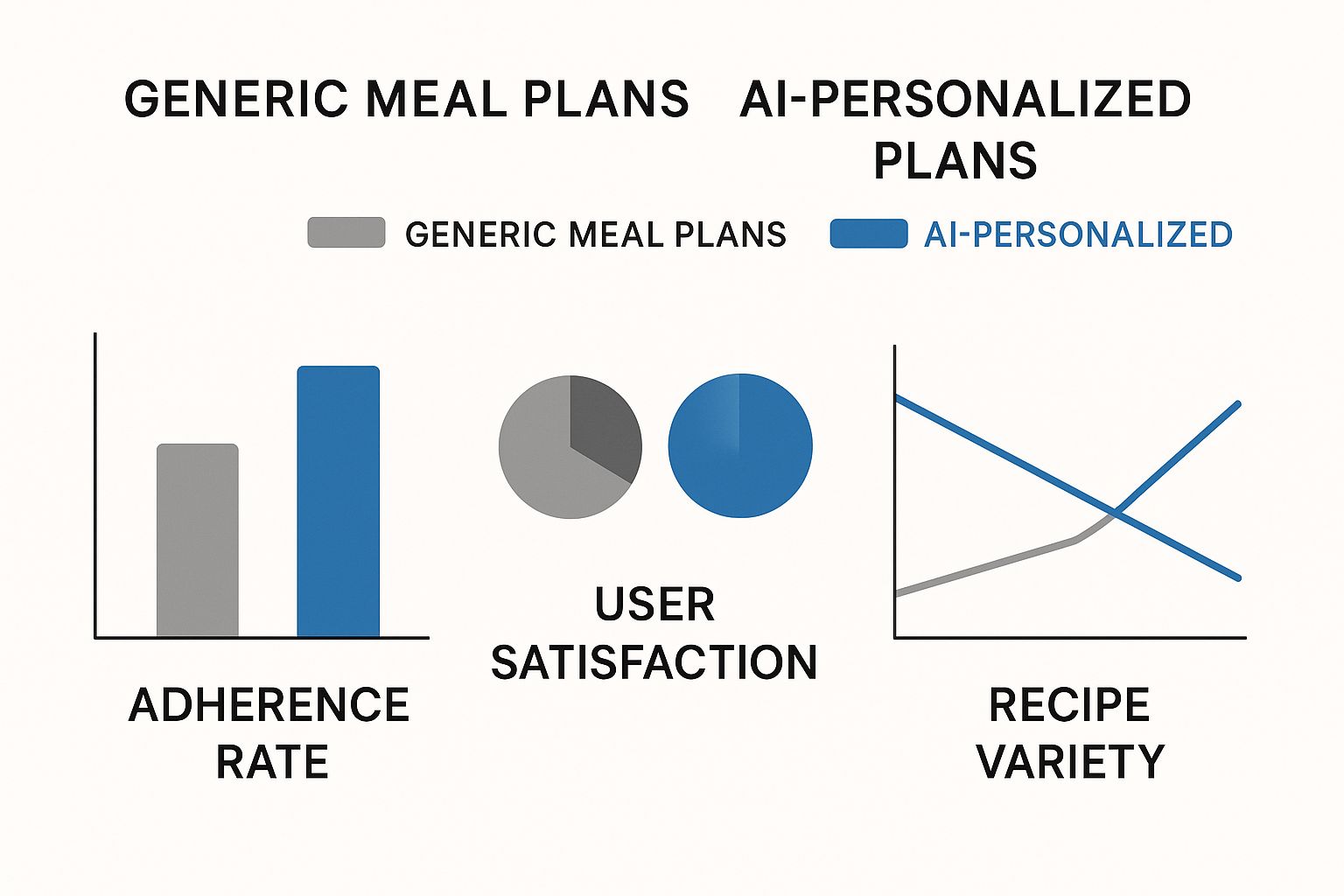
As you can see, personalization leads directly to better results. By making healthy eating more relevant and enjoyable, AI dramatically increases the odds that you'll stick with it for the long haul—turning a short-term diet into a lifestyle you love.
Finding the Right Meal Planning App for Your Lifestyle
With so many meal planning apps out there, picking one can feel as tough as figuring out what’s for dinner tonight. But here’s the secret: there’s no single “best” app for everyone. The right one is the one that fits your life. Think of it like buying shoes—a marathon runner needs something completely different from a casual hiker. Your perfect app depends entirely on your goals, your schedule, and who you’re feeding.
Instead of getting bogged down comparing endless feature lists, start by thinking about your biggest kitchen headaches. Are you trying to please a family of picky eaters? Or are you a gym-goer who needs to hit specific protein targets? Answering that question first will help you cut through the noise and find a tool that actually makes your life easier.
Best Apps for Busy Families
For families, it’s a constant battle against the clock and a chorus of “I don’t want that!” The best apps for this crowd are all about efficiency and flexibility. They’re packed with quick, kid-friendly recipes and features that bring a little order to the chaos.
- Shared Accounts and Lists: Look for apps that let everyone in the family log in to add recipe ideas or mark off items on the grocery list. This simple feature is a game-changer for avoiding those "we're out of milk" emergencies.
- Kid-Friendly Filters: The top family apps let you filter for recipes that are tried-and-true winners with kids, usually meaning simple ingredients and quick prep.
- "Use What You've Got" Features: These are absolute lifesavers. You can plug in the ingredients you already have, and the app will suggest recipes. It’s a brilliant way to reduce food waste and skip an extra trip to the store.
When an app solves these core problems, it becomes more than a digital recipe book—it’s the command center for your kitchen.
Top Choices for Specific Diets like Keto or Vegan
If you’re following a strict diet—like keto, vegan, paleo, or low-FODMAP—you know that precision is everything. A stray ingredient can completely throw you off track. This is where a generic, one-size-fits-all app just won’t do the job. You need an app that acts as a dedicated gatekeeper for your diet.
The best healthy meal planning app for a specific diet is one that takes the burden of constant label-reading and recipe modification off your plate. It should empower you to explore new foods with confidence, knowing they align perfectly with your dietary needs.
Go beyond a simple "vegan" checkbox. The best apps for specialized diets will let you:
- Set Strict Dietary Rules: You need the ability to completely ban certain food groups, whether it's dairy, grains, or all animal products.
- Track Key Metrics: For keto, tracking net carbs is what matters, not total carbs. A specialized app does that math for you.
- Access a Vetted Recipe Database: Nothing beats a library of delicious recipes that were created specifically for your diet, so you know they’ll work.
Best Apps for Budget-Conscious Cooks
Eating healthy on a budget is totally possible, and the right app can be your secret weapon for saving money. These apps are built to help you make every dollar count by fighting food waste and helping you shop smarter.
The standout feature is often some form of price tracking or integration with local store sales. Some apps will even scan weekly flyers and plan your meals around the best deals, turning junk mail into a goldmine of savings. Understanding what makes an app truly convenient and affordable is key, especially for specific groups like students. For instance, looking at the top food ordering apps for college students offers a great perspective on what budget-friendly functionality really looks like in practice.
Perfect Picks for Fitness Enthusiasts
If you live and breathe macros, your meal planning app needs to speak that language. For athletes, bodybuilders, and anyone serious about their fitness, nutrition is a numbers game. You don't just need recipe ideas; you need a precision tool for hitting your protein, carb, and fat goals every single day.
The absolute must-have feature here is granular macronutrient tracking. The best fitness-focused apps let you set macro targets for each day—or even each meal—and then build a plan that nails those numbers. Many also sync with fitness trackers, automatically adjusting your calorie recommendations based on your workouts. This creates a powerful connection between your training and your plate, ensuring your food is always fueling your performance.
To see how this works in action, you can explore various https://ai-mealplan.com/plans tailored for specific fitness outcomes like building muscle or losing fat.
Before we move on, let's look at how some of the leading apps stack up against each other.
Feature Comparison of Leading Meal Planning Apps
Choosing an app is easier when you see everything laid out side-by-side. This table breaks down some popular options to help you quickly spot the one that might be the best fit for your kitchen.
| App Name | Best For | Key Features | Pricing Model |
|---|---|---|---|
| Mealime | Busy Professionals & Couples | Highly customizable recipes, super-fast meal plans, smart grocery lists. | Freemium (Free basic, Premium for advanced features) |
| Paprika | Hands-On Home Cooks | One-time purchase, recipe importing from any website, pantry management. | One-Time Purchase |
| PlateJoy | Personalized Health Goals | In-depth dietary customization, optional ingredient delivery, weight loss focus. | Subscription-Based |
| Eat This Much | Fitness & Macro Tracking | Automatic meal generation based on calorie/macro targets, highly precise. | Freemium (Free basic, Premium for full customization) |
| Yummly | Recipe Discovery & Variety | Massive recipe database, personalized recommendations, shopping list integration. | Freemium (Free with optional subscription for guided recipes) |
As you can see, the "best" app really comes down to your primary goal—whether that's saving time, hitting a new personal record at the gym, or getting your family to eat more veggies.
Making Your Meal Planning App a Daily Habit
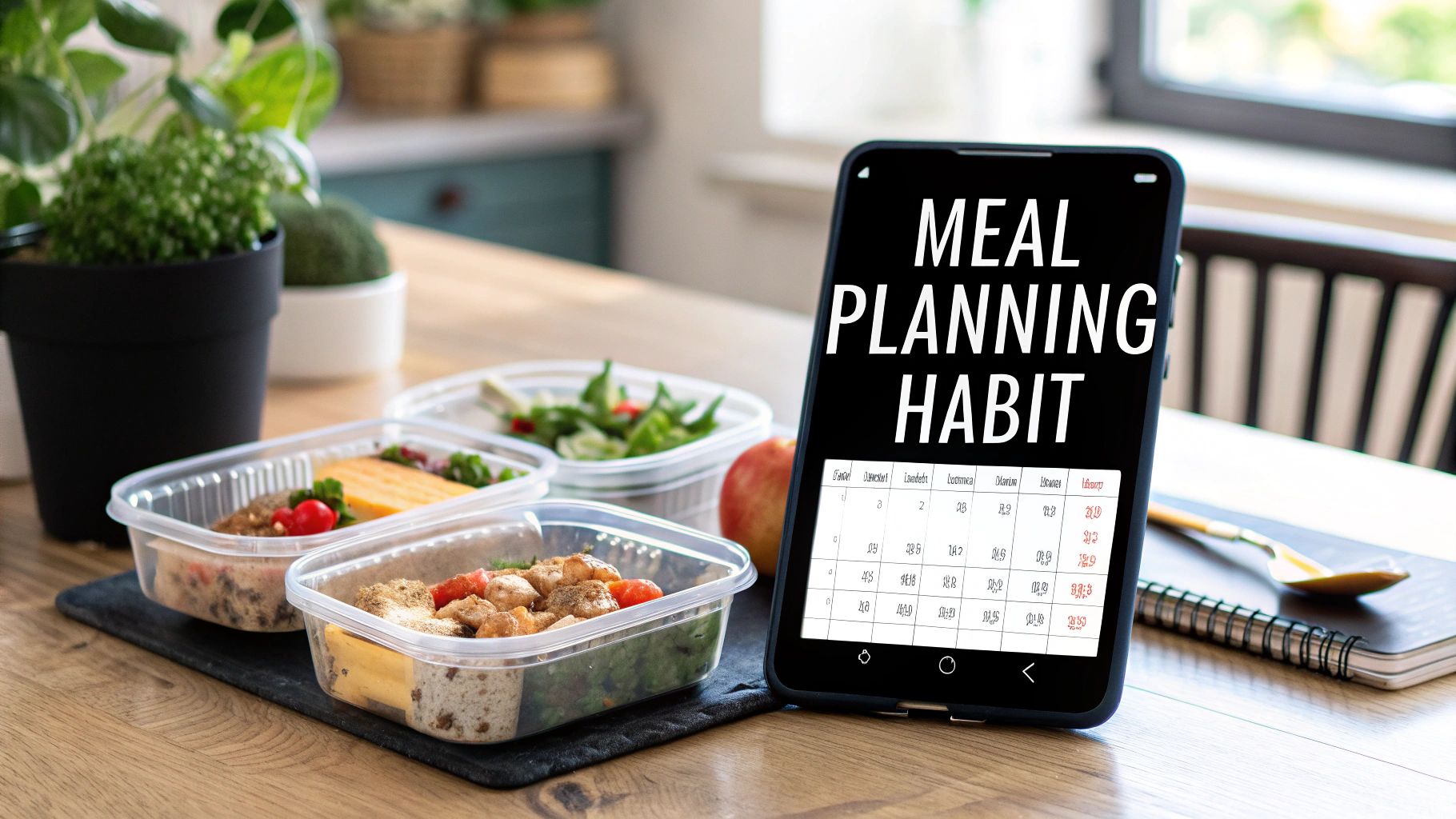
The best meal planning app in the world isn't the one with the fanciest features—it's the one you actually use. Think of it like a new gym membership; the initial buzz wears off quickly if you don’t build a real routine. The trick is to weave the app into your weekly schedule until checking it feels as natural as checking your email.
It's all about creating small, sustainable habits that stick. Forget trying to overhaul your entire life overnight. Instead, focus on integrating the app in manageable steps. Your goal is to make it a reliable partner in your kitchen, not just another chore on your to-do list.
Your Step-by-Step Guide to Getting Started
Jumping into a new app can feel a little overwhelming, but breaking it down makes all the difference. This is your quick-start guide to a healthier lifestyle, one simple action at a time. Don't try to master everything at once; just focus on getting the ball rolling.
Set Up Your Profile (15 Minutes): This is the most crucial step, so don't rush it. Take a few minutes to accurately plug in your dietary needs, health goals, allergies, and even the ingredients you absolutely hate. A detailed profile is what lets the app’s algorithm serve up personalized meal suggestions you'll actually want to eat.
Plan Your First Week (20 Minutes): Perfection is not the goal here. Just start by planning three to four dinners for the week ahead. This is way less intimidating than mapping out 21 different meals, and it sets you up for an easy win right out of the gate.
Generate Your First Grocery List (5 Minutes): Once your meals are locked in, let the app do the heavy lifting. With a single tap, it should crunch all the ingredients into an organized shopping list. Scan it for items you already have in the pantry, and you're ready to hit the store with a clear plan.
That's it. This initial setup shouldn't take more than 40 minutes, but it lays the groundwork for an entire week of stress-free, healthy eating.
Practical Tips for Long-Term Success
Okay, you're set up. Now, the real challenge begins: consistency. The secret to making a new habit last is to make the process as easy and rewarding as possible. These strategies are designed to help you stick with it, week after week.
Schedule a Planning Session: Treat meal planning like an important appointment. Block out 20 minutes every Sunday evening to map out the week. Putting it in your calendar makes it official and much harder to skip.
Master the Art of the Leftover: Don't think of leftovers as just a boring repeat meal. Think strategically. Plan to make a little extra grilled chicken for dinner tonight, and you’ve got the perfect protein for a salad or wrap for tomorrow's lunch. This "cook once, eat twice" trick is a massive time-saver.
Start Small to Build Momentum: If planning three dinners feels like too much, just plan one. Seriously. The goal is to create a positive feedback loop. Once you feel that sense of calm that comes from knowing dinner is handled, you'll be motivated to plan a second, and then a third.
Consistency trumps intensity every single time. The simple act of planning a few meals each week is far more powerful than some ambitious, all-or-nothing plan that you abandon after a few days.
Overcoming Common Hurdles
Even with the best of intentions, life happens. You'll get busy, your motivation will dip, and old habits will try to creep back in. Knowing these challenges will pop up is the first step to beating them and keeping your healthy eating journey on track.
Feeling bored with your meals? Use the app's recipe discovery feature to find one new dish to try each week. Crunched for time? Filter for recipes that take under 30 minutes to prepare. A good meal planning app is a flexible tool. Learn to adjust its settings to fit the reality of your week, and you’ll find it’s much easier to stick with for the long haul.
The Bigger Picture of Digital Nutrition Tools
A healthy meal planning app doesn't operate in a silo. It’s a key player in a much broader ecosystem of digital wellness tools, all designed to help us live healthier. Think of your meal planner as the central hub, connecting all the different spokes of your well-being. Your fitness tracker diligently counts your steps and calories burned, but it's your meal planner that ensures you're actually fueling that activity with the right stuff.
This is where the real magic happens—when these tools talk to each other. When your meal planning app syncs up with your calorie counter or your smartwatch, you create a seamless feedback loop. Suddenly, your food choices are directly informed by how active you've been, and your workout plans can be adjusted based on your nutrition. It paints a complete picture of your health, where diet and exercise are finally working together instead of being treated as two separate chores.
Beyond the Kitchen: The Long-Term Payoff
Using a meal planning app consistently delivers benefits that ripple out into every area of your life. Sure, the immediate perks are great—less time stressing about what's for dinner is a huge win. But the long-term rewards are where you'll find the real value. Sticking with a plan helps you build sustainable habits, and that's what leads to profound, lasting change.
Over time, you’ll likely notice:
- Better Health Markers: Consistent, balanced nutrition has a direct and measurable impact on things like your cholesterol, blood pressure, and blood sugar levels.
- Sustainable Eating Habits: The app becomes a sort of nutrition coach, teaching you portion control, nutrient balance, and mindful eating. These are skills that stick with you for a lifetime.
- Serious Financial Savings: Planning meals means fewer impulse buys at the grocery store and a lot less food waste. It's not uncommon for people to save hundreds of dollars a year.
This shift toward proactive health isn't just a personal one; it's a global trend. The entire diet and nutrition app industry, valued at an impressive USD 2.14 billion in 2024, is expected to more than double, reaching USD 4.56 billion by 2030. This boom is fueled by a collective desire to take control of our health, with North America currently leading the way. You can dig deeper into the diet and nutrition app market growth from Grand View Research for more on these trends.
A Cornerstone of a Modern Health-Conscious Lifestyle
At the end of the day, a meal planning app is more than just a piece of software. It’s a foundational tool for anyone taking a modern, proactive approach to their own wellness. It hands you the reins to one of the most critical aspects of your health: what you put on your plate. By cutting through the noise and eliminating decision fatigue, it frees up your mental energy to focus on everything else that contributes to your well-being.
When you see how your app fits into a holistic health strategy, it stops being just a tool for planning dinner. It becomes a cornerstone of a lifestyle built on intention, consistency, and self-care.
It’s really about making conscious choices instead of reactive ones. In a world full of distractions and convenient (but often unhealthy) options, a good meal planning app acts as your anchor. It keeps you grounded in your goals and helps you consistently move toward a healthier, more vibrant version of yourself.
Got Questions? We've Got Answers
Jumping into the world of meal planning apps can feel like a big step, so it's natural to have a few questions. Let's tackle some of the most common ones we hear from people who are just getting started.
Are These Apps Actually Worth the Money?
It's a fair question. For most people, the answer is a resounding yes. Think about how much you save by not buying things on impulse at the grocery store or wasting food that goes bad. These apps generate super-specific shopping lists, which helps you buy only what you need.
Plus, you get back so much time each week. That alone is often worth the small subscription fee.
Pro tip: Nearly all the best apps offer a free trial. Give one a spin for a week or two. You'll quickly see if the savings and convenience work for you before you spend a dime.
What About Serious Allergies or Really Specific Diets?
This is where these apps truly shine. Any good meal planning app is built for customization. You can easily filter out common allergens like gluten, nuts, and dairy, and they're designed to handle specific eating styles like vegan, keto, paleo, or even low-FODMAP.
Of course, you should always double-check labels yourself, but the app does the heavy lifting to make sticking to your strict dietary needs a whole lot easier.
How Much Time Will This Really Take Me Each Week?
Getting set up for the first time will probably take about 30 minutes. You'll plug in your goals, food preferences, and any ingredients you want to avoid.
But after that? It's incredibly fast. You can genuinely plan a full week of meals and have a perfectly organized shopping list in your hands in just 15-20 minutes. The app handles all the tedious parts, so you can say goodbye to that daily "what's for dinner?" panic.
Ready to stop stressing and start enjoying healthy meals? The AI Meal Planner creates personalized plans that fit your life. Discover your perfect meal plan.
AI-powered nutrition
Get Your Personalized Meal Plan
AI creates the perfect meals for your goals, lifestyle, and taste.
Start Your Journej